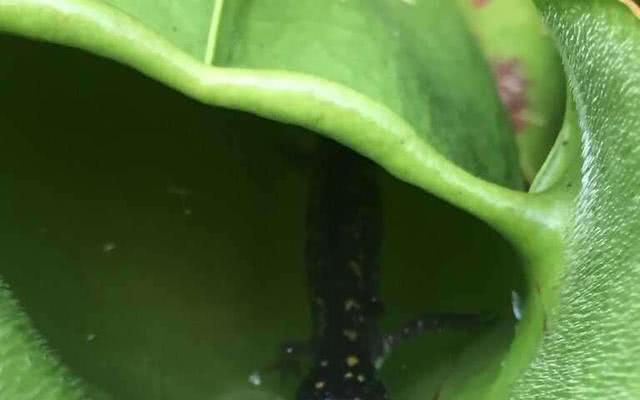(单词翻译:单击)
听力文本
Researchers Discover Meat-Eating Plant in Canada
Researchers say they have discovered a plant in Canada that not only eats insects, but also feeds on at least one amphibious creature.
The discovery was recently reported in a study by a research team from Canada's University of Guelph in Ontario. The study was published in the journal Ecology.
The research involved pitcher plants in Ontario's Algonquin Provincial Park. The plants – which take many shapes and sizes and have colorful designs — grow in wetlands across Canada.
A pitcher plant's leaves usually form a tall, narrow pocket that can hold liquid. Insects and spiders that enter the pocket often become trapped and the pitcher plant then feeds on their bodies.
Pitcher plants are often found in bogs — soft, extremely wet areas. The plants are known for feeding on small organisms – such as insects and spiders – that get caught in the trap.
But the researchers made a surprising discovery — the pitcher plants were also feeding on young salamanders. A salamander is a lizard-like amphibian.
The research team said it believes this is the first time any North American pitcher plants have been observed feeding on anything besides insects or spiders.
In the summer of 2017, then University of Guelph student Teskey Baldwin found a salamander trapped inside a pitcher plant while doing field work in the provincial park. One of the biggest surprises was that the discovery did not happen earlier, the researchers said.
Alex Smith is a biology professor at the University of Guelph and co-writer of the study. He told Canada's CTV News the research station near the bog where the pitcher plants were observed has been there for 70 years.
"So the surprise was that we discovered such a new case of plants eating vertebrates involving such a well-known species in such a well-known space," Smith said.

During visits to a single area of the park in fall of 2018, the research team found almost one in five pitcher plants contained young salamanders. The amphibians were each about as long as a human finger.
Several plants contained more than one captured salamander. Some of the trapped salamanders died within three days, while others lived for up to 19 days, the study found.
The researchers said they do not know what killed the salamanders. They could have died from proteins produced by the pitcher plants that are held in liquid inside the leaves. This liquid mixture is designed to break down organisms trapped in the plants to aid the feeding process.
The researchers suggested other possible causes for the salamander deaths could have included heat, starvation or infections. Organisms living in the pitcher may also help break down the salamanders' bodies.
The study found that there are also several possible reasons the young salamanders are drawn to the plants in the first place. One is that they fall into the plant pockets accidentally. They also could go in to find a place to hide or to feed on insects or spiders already trapped there.
The researchers say pitcher plants clearly get a lot more nutrients from salamanders than from insects and spiders. So there is no reason to think that the plants will not continue feeding on them.
Meat-eating pitcher plants have been known since the eighteenth century, the University of Guelph says. One species discovered 10 years ago in Asia feeds mostly on insects and spiders, but sometimes captures small birds and mice.
Alex Smith said the discovery opens some new questions that future research might help explain. Are salamanders an important feeding source for pitcher plants? Are the plants important "predators" of the amphibians? Might the salamanders compete with plants for insect food?
The university said the discovery area could even be called the "Little Bog of Horrors" after a Broadway musical and film that includes a giant plant that likes to eat people.
I'm Bryan Lynn.
重点解析
重点讲解:
1. not only... but also... 不但…而且…;
He not only read the book, but also remembered what he had read.
他不但读了这本书,而且记得所读的内容。
2. be known for 以…闻名的;
Levi is best known for work in a very different mode from what is to be found here.
利瓦伊最为人所知之处在于他的工作风格同这里的人迥然不同。
3. break down (使)(物质)分解;
Sugar and starch are broken down in the stomach.
糖和淀粉在胃里被分解。
4. in the first place 起初;一开始;
I hear an echo of the thinking that got us into this mess in the first place.
我听到有人重提那个最先使我们陷入这一困境的想法。
参考译文
研究人员在加拿大发现了肉食植物
研究人员表示,他们在加拿大发现了一种植物,这种植物不仅吃昆虫,还会食用至少一种两栖动物。
来自加拿大安大略省圭尔夫大学的研究小组最近在一项研究论文中报告了这一发现。这项研究发表在《生态学》期刊上。
该研究聚焦安大略省阿岗昆省立公园的猪笼草。这种植物生长在加拿大各处的湿地中,形状各异、大小不一,而且色彩斑斓。
猪笼草的叶子通常会形成一个又长又窄的“口袋”,里面可以储存液体。进入这一“口袋”的昆虫和蜘蛛会被困在里面,然后猪笼草会吃掉它们的尸体。
猪笼草通常生长在沼泽地区,即又软又极度潮湿的地区。这种植物因食用小型生物而闻名,比如被困住的昆虫和蜘蛛。
但是研究人员报告了一个惊人的发现——猪笼草也食用蝾螈幼崽。蝾螈是类似蜥蜴的两栖动物。
研究小组表示,他们认为这是研究人员首次观察到北美地区的猪笼草食用除昆虫或蜘蛛以外的生物。
2017年夏天,当时在圭尔夫大学就读的学生特斯基·鲍德温在阿岗昆省立公园进行实地考查,他发现一只蝾螈被困在了猪笼草中。研究人员表示,没有早些发现这一情况是最令人吃惊的事情之一。
亚历克斯·史密斯是圭尔夫大学的生物学教授,也是这项研究的共同作者。他对加拿大 CTV News表示,沼泽附近有一个观察猪笼草的研究站,而这家研究站已经设立了70年。
史密斯说:“令人吃惊的是,我们发现了一种食用脊椎动物的新植物,而且这种植物是生长在著名地区的知名物种。”
研究小组在2018年秋天考察了该公园的一个区域,他们发现几乎有五分之一的猪笼草里都有被困住的蝾螈幼崽。每个被困幼崽的体长大约都有人类手指那么长。
多个猪笼草里有不止一只被困住的蝾螈。研究发现,其中一些受困蝾螈不到3天就会死亡,而其它蝾螈则可以坚持存活19天。
研究人员表示,他们不知道这些蝾螈为什么会死亡。导致蝾螈死亡的可能是猪笼草叶子内的液体所分泌的蛋白质。这种液体混合物旨在分解被困在猪笼草里的生物体,以辅助进食。
研究人员认为,造成蝾螈死亡的其他原因可能包括高温、饥饿或感染。猪笼草里的有机体可能还会帮助分解蝾螈的尸体。
研究发现,蝾螈幼崽最开始掉进猪笼草的原因可能有几个。其一,这些幼崽可能是不小心掉进去的。它们进入猪笼草也可能是在寻找躲藏的地方或是想吃被困在猪笼草里的昆虫或蜘蛛。
研究人员表示,相比于昆虫和蜘蛛,猪笼草显然能从食用蝾螈中获得更多养分。因此,没有理由认为猪笼草不会继续食用蝾螈。
圭尔夫大学表示,食肉猪笼草早在18世纪就为人所知。10年前在亚洲发现的一个猪笼草物种主要以昆虫和蜘蛛为食,但有时也会捕捉小鸟和老鼠。
亚历克斯·史密斯表示,这一发现引发了许多新问题,也许未来的研究能进行解答。蝾螈是猪笼草的重要食物来源吗?猪笼草是蝾螈重要的“捕食者”吗?蝾螈会和植物竞争昆虫食物吗?
圭尔夫大学表示,这一发现区甚至可能会以百老汇音乐剧和电影《恐怖小店》命名,该作品里有一种喜欢吃人的巨型植物。
布莱恩·林恩报道。
译文为可可英语翻译,未经授权请勿转载!


